Land Use and Land Cover Change Patterns from Orbital Remote Sensing Products: Spatial Dynamics and Trend Analysis in Northeastern Brazil
Abstract
1. Introduction
2. Materials and Methods
2.1. Characterization of the Study Area
2.2. Processing, Statistical Tests and Classification of LULC Data (MapBiomas)
2.2.1. LULC Classification and Cloud Processing
2.2.2. Estimation of Spectral and Surface Indices, Predictor Variables and Their Statistical Reducers
2.2.3. Mann–Kendall and Sen’s Slope Trend Tests in LULC Data
2.3. TRMM_3B43v7 Data and Surface Data Validation
2.4. Data from Terra and Aqua Satellites (MODIS Sensor)
2.5. Multivariate Principal Component Analysis (PCA)
2.6. Statistical Analysis
3. Results and Discussion
3.1. Spatiotemporal Dynamics of LULC, Global Accuracy and Surface Albedo
3.2. Dynamics of Quantitative Variability of LULC Data
3.3. Trend Analysis from Mann–Kendall and Sen’s Slope
3.4. Multivariate Analysis: Principal Components (PC)
4. Conclusions
Author Contributions
Funding
Data Availability Statement
Acknowledgments
Conflicts of Interest
References
- Fendrich, A.N.; Barretto, A.; de Faria, V.G.; de Bastiani, F.; Tenneson, K.; Guedes Pinto, L.F.; Sparovek, G. Disclosing Contrasting Scenarios for Future Land Cover in Brazil: Results from a High-Resolution Spatiotemporal Model. Sci. Total Environ. 2020, 742, 140477. [Google Scholar] [CrossRef] [PubMed]
- Leng, X.; Feng, X.; Fu, B. Driving Forces of Agricultural Expansion and Land Degradation Indicated by Vegetation Continuous Fields (VCF) Data in Drylands from 2000 to 2015. Glob. Ecol. Conserv. 2020, 23, e01087. [Google Scholar] [CrossRef]
- Liu, Y.; Guo, B.; Lu, M.; Zang, W.; Yu, T.; Chen, D. Quantitative Distinction of the Relative Actions of Climate Change and Human Activities on Vegetation Evolution in the Yellow River Basin of China during 1981–2019. J. Arid Land 2023, 15, 91–108. [Google Scholar] [CrossRef]
- Parracciani, C.; Buitenwerf, R.; Svenning, J.C. Impacts of Climate Change on Vegetation in Kenya: Future Projections and Implications for Protected Areas. Land 2023, 12, 2052. [Google Scholar] [CrossRef]
- da Silva Pinto Vieira, R.M.; Tomasella, J.; Cunha, A.P.M.D.A.; Barbosa, A.A.; Pompeu, J.; Ferreira, Y.; Santos, F.C.; Alves, L.M.; Ometto, J. Socio-Environmental Vulnerability to Drought Conditions and Land Degradation: An Assessment in Two Northeastern Brazilian River Basins. Sustainability 2023, 15, 8029. [Google Scholar] [CrossRef]
- da Silva, J.L.B.; da Silva, M.V.; da Rosa Ferraz Jardim, A.M.; Lopes, P.M.O.; de Oliveira, H.F.E.; Silva, J.A.O.S.; Mesquita, M.; de Carvalho, A.A.; Cézar Bezerra, A.; de Oliveira-Júnior, J.F.; et al. Geospatial Insights into Aridity Conditions: MODIS Products and GIS Modeling in Northeast Brazil. Hydrology 2024, 11, 32. [Google Scholar] [CrossRef]
- Song, Z.; Lu, Y.; Yuan, J.; Lu, M.; Qin, Y.; Sun, D.; Ding, Z. Research on Desertification Monitoring and Vegetation Refinement Extraction Methods Based on the Synergy of Multi-Source Remote Sensing Imagery. IEEE Trans. Geosci. Remote Sens. 2025, 63, 1–19. [Google Scholar] [CrossRef]
- Marengo, J.A.; Cunha, A.P.M.A.; Nobre, C.A.; Ribeiro Neto, G.G.; Magalhaes, A.R.; Torres, R.R.; Sampaio, G.; Alexandre, F.; Alves, L.M.; Cuartas, L.A.; et al. Assessing Drought in the Drylands of Northeast Brazil under Regional Warming Exceeding 4 °C. Nat. Hazards 2020, 103, 2589–2611. [Google Scholar] [CrossRef]
- Akinyemi, F.O. Vegetation Trends, Drought Severity and Land Use-land Cover Change during the Growing Season in Semi-arid Contexts. Remote Sens. 2021, 13, 836. [Google Scholar] [CrossRef]
- Guo, B.; Wei, C.; Yu, Y.; Liu, Y.; Li, J.; Meng, C.; Cai, Y. The dominant influencing factors of desertification changes in the source region of Yellow River: Climate change or human activity? Sci. Total Environ. 2022, 813, 152512. [Google Scholar] [CrossRef]
- Barbosa, H.A. Flash Drought and Its Characteristics in Northeastern South America during 2004–2022 Using Satellite-Based Products. Atmosphere 2023, 14, 1629. [Google Scholar] [CrossRef]
- Kumar, B.P.; Anusha, B.N.; Babu, K.R.; Sree, P.P. Identification of climate change impact and thermal comfort zones in semi-arid regions of AP, India using LST and NDBI techniques. J. Clean. Prod. 2023, 407, 137175. [Google Scholar] [CrossRef]
- Paredes-Trejo, F.; Barbosa, H.A.; Daldegan, G.A.; Teich, I.; García, C.L.; Kumar, T.V.L.; de Oliveira Buriti, C. Impact of Drought on Land Productivity and Degradation in the Brazilian Semiarid Region. Land 2023, 12, 954. [Google Scholar] [CrossRef]
- Silva, J.L.B.; Moura, G.B.A.; Silva, M.V.; Oliveira-Júnior, J.F.; Jardim, A.M.D.R.F.; Refati, D.C.; da Cunha Correia Lima, R.; de Carvalho, A.A.; Ferreira, M.B.; de Brito, J.I.B.; et al. Environmental degradation of vegetation cover and water bodies in the semiarid region of the Brazilian northeast via cloud geoprocessing techniques applied to orbital data. J. South Am. Earth Sci. 2023, 121, 104164. [Google Scholar] [CrossRef]
- Manikanta, B.; Yaswanth, K.K. Impact Assessment of Future LULC and Climate Change on Hydrology in the Upper Pennar Basin, India. Sustain. Water Resour. Manag. 2025, 11, 15. [Google Scholar] [CrossRef]
- Stríkis, N.M.; Buarque, P.F.S.M.; Cruz, F.W.; Bernal, J.P.; Vuille, M.; Tejedor, E.; Santos, M.S.; Shimizu, M.H.; Ampuero, A.; Du, W.; et al. Modern Anthropogenic Drought in Central Brazil Unprecedented during Last 700 Years. Nat. Commun. 2024, 15, 1728. [Google Scholar] [CrossRef]
- Tomasella, J.; Silva Pinto Vieira, R.M.; Barbosa, A.A.; Rodriguez, D.A.; de Oliveira Santana, M.; Sestini, M.F. Desertification Trends in the Northeast of Brazil over the Period 2000–2016. Int. J. Appl. Earth Obs. Geoinf. 2018, 73, 197–206. [Google Scholar] [CrossRef]
- da Rosa Ferraz Jardim, A.M.; Araújo Júnior, G.D.N.; da Silva, M.V.; Dos Santos, A.; da Silva, J.L.B.; Pandorfi, H.; de Oliveira-Júnior, J.F.; de Castro Teixeira, A.H.; Teodoro, P.E.; de Lima, J.L.M.P.; et al. Using Remote Sensing to Quantify the Joint Effects of Climate and Land Use/Land Cover Changes on the Caatinga Biome of Northeast Brazilian. Remote Sens. 2022, 14, 1911. [Google Scholar] [CrossRef]
- Oliveira, M.L.; dos Santos, C.A.; de Oliveira, G.; Silva, M.T.; da Silva, B.B.; Cunha, J.E.B.L.; Ruhoff, A.; Santos, C.A.G. Remote sensing-based assessment of land degradation and drought impacts over terrestrial ecosystems in Northeastern Brazil. Sci. Total Environ. 2022, 835, 155490. [Google Scholar] [CrossRef]
- Refati, D.C.; Silva, J.L.B.; Macedo, R.S.; Lima, R.C.C.; Silva, M.V.; Pandorfi, H.; Silva, P.C.; de Oliveira-Júnior, J.F. Influence of drought and anthropogenic pressures on land use and land cover change in the Brazilian semiarid region. J. South Am. Earth Sci. 2023, 126, 104362. [Google Scholar] [CrossRef]
- Barbosa, H.A. Understanding the Rapid Increase in Drought Stress and Its Connections with Climate Desertification since the Early 1990s over the Brazilian Semi-Arid Region. J. Arid Environ. 2024, 222, 105142. [Google Scholar] [CrossRef]
- Rocha, W.J.S.F.; Vasconcelos, R.N.; Costa, D.P.; Duverger, S.G.; Lobão, J.S.B.; Souza, D.T.M.; Herrmann, S.M.; Santos, N.A.; Rocha, R.O.F.; Ferreira-Ferreira, J.; et al. Towards Uncovering Three Decades of LULC in the Brazilian Drylands: Caatinga Biome Dynamics (1985–2019). Land 2024, 13, 1250. [Google Scholar] [CrossRef]
- Oliveira, P.T.; Santos e Silva, C.M.; Lima, K.C. Climatology and Trend Analysis of Extreme Precipitation in Subregions of Northeast Brazil. Theor. Appl. Climatol. 2017, 130, 77–90. [Google Scholar] [CrossRef]
- Marengo Orsini, J.A.; Alves, L.M.; Alvala, R.C.S.; Cunha, A.P.; Brito, S.; Moraes, O.L.L. Climatic Characteristics of the 2010-2016 Drought in the Semiarid Northeast Brazil Region. An. Acad. Bras. Cienc. 2018, 90, 1973–1985. [Google Scholar] [CrossRef] [PubMed]
- Costa, R.L.; de Mello Baptista, G.M.; Gomes, H.B.; Daniel dos Santos Silva, F.; Lins da Rocha Júnior, R.; de Araújo Salvador, M.; Herdies, D.L. Analysis of Climate Extremes Indices over Northeast Brazil from 1961 to 2014. Weather Clim. Extrem. 2020, 28, 100254. [Google Scholar] [CrossRef]
- Rezende, L.F.; Alves, L.; Barbosa, A.A.; Sales, A.T.; Pedra, G.U.; Menezes, R.S.C.; Arcoverde, G.F.; Ometto, J.P. Greening and Water Use Efficiency during a Period of High Frequency of Droughts in the Brazilian Semi-Arid. Front. Water 2023, 5, 1295286. [Google Scholar] [CrossRef]
- Barbosa, H.A.; de Oliveira Buriti, C. Assessment of Long-Term Streamflow Response to Flash Drought in the São Francisco River Basin over the Last Three Decades (1991–2020). Water 2024, 16, 2271. [Google Scholar] [CrossRef]
- Santos, J.A.S.; Wanderley, H.S.; de Amorim, R.F.C.; Delgado, R.C.; Fernades, R.C. The longest multiannual drought in Northeastern Brazil. J. S. Am. Earth Sci. 2024, 143, 104976. [Google Scholar] [CrossRef]
- Mariano, D.A.; Santos, C.A.C.D.; Wardlow, B.D.; Anderson, M.C.; Schiltmeyer, A.V.; Tadesse, T.; Svoboda, M.D. Use of Remote Sensing Indicators to Assess Effects of Drought and Human-Induced Land Degradation on Ecosystem Health in Northeastern Brazil. Remote Sens. Environ. 2018, 213, 129–143. [Google Scholar] [CrossRef]
- Nogueira, E.M.; Clemente, C.M.S.; Yanai, A.M.; dos Reis, M.; Fearnside, P.M. Cutting of Dry Forests in a Semiarid Region of Northeastern Brazil. Reg. Environ. Change 2024, 24, 25. [Google Scholar] [CrossRef]
- Flores, B.M.; Montoya, E.; Sakschewski, B.; Nascimento, N.; Staal, A.; Betts, R.A.; Levis, C.; Lapola, D.M.; Esquível-Muelbert, A.; Jakovac, C.; et al. Critical Transitions in the Amazon Forest System. Nature 2024, 626, 555–564. [Google Scholar] [CrossRef] [PubMed]
- Oliveira, A.C.; Sehn Körting, T. A multi-temporal dataset for mapping burned areas in the Brazilian Cerrado using time series of remote sensing imagery. Big Earth Data 2025, 9, 473–504. [Google Scholar] [CrossRef]
- Souza, C.M., Jr.; Shimbo, J.Z.; Rosa, M.R.; Parente, L.L.; Alencar, A.A.; Rudorff, B.F.; Hasenack, H.; Matsumoto, M.; Ferreira, L.G.; Souza-Filho, P.W.M.; et al. Reconstructing three decades of land use and land cover changes in brazilian biomes with landsat archive and earth engine. Remote Sens. 2020, 12, 2735. [Google Scholar] [CrossRef]
- MapBiomas Project. Collection 5 of the Annual Land Cover and Land Use Maps of Brazil (1985–2019). 2024. Available online: https://brasil.mapbiomas.org/produtos/ (accessed on 1 October 2020).
- Carvalho, A.A.; Lopes, I.; da Silva, O.F. Tendências observadas na precipitação sobre a Bacia do Riacho do Navio (Pernambuco). Anuário Do Inst. De Geociências 2019, 42, 56–70. [Google Scholar] [CrossRef]
- Bezerra, A.C.; Silva, J.L.B.; Moura, G.B.A.; Lopes, P.M.O.; Nascimento, C.R.; Ribeiro, E.P.; Galvíncio, J.D.; da Silva, M.V. Dynamics of land cover and land use in Pernambuco (Brazil): Spatio-temporal variability and temporal trends of biophysical parameters. Remote Sens. Appl. Soc. Environ. 2022, 25, 100677. [Google Scholar] [CrossRef]
- Dong, D.; Zhang, R.; Guo, W.; Gong, D.; Zhao, Z.; Zhou, Y.; Xu, Y.; Fujioka, Y. Assessing Spatiotemporal Dynamics of Net Primary Productivity in Shandong Province, China (2001–2020) Using the CASA Model and Google Earth Engine: Trends, Patterns, and Driving Factors. Remote Sens. 2025, 17, 488. [Google Scholar] [CrossRef]
- Wang, S.; Grant, R.F.; Verseghy, D.L.; Black, T.A. Modelling Plant Carbon and Nitrogen Dynamics of a Boreal Aspen Forest in CLASS-The Canadian Land Surface Scheme. Ecol. Model. 2001, 142, 135–154. [Google Scholar] [CrossRef]
- Tasumi, M.; Allen, R.G.; Trezza, R. At-Surface Reflectance and Albedo from Satellite for Operational Calculation of Land Surface Energy Balance. J. Hydrol. Eng. 2008, 13, 51–63. [Google Scholar] [CrossRef]
- Silva, B.B.D.; Braga, A.C.; Braga, C.C.; de Oliveira, L.M.; Montenegro, S.M.; Barbosa Junior, B. Procedures for calculation of the albedo with OLI-Landsat 8 images: Application to the Brazilian semi-arid. Rev. Bras. Eng. Agrícola Ambient. 2016, 20, 3–8. [Google Scholar] [CrossRef]
- Zheng, L.; Qi, Y.; Qin, Z.; Xu, X.; Dong, J. Assessing Albedo Dynamics and Its Environmental Controls of Grasslands over the Tibetan Plateau. Agric. For. Meteorol. 2021, 307, 108479. [Google Scholar] [CrossRef]
- IBGE. Instituto Brasileiro de Geografia e Estatística. Biomas e Sistema Costeiro-Marinho do Brasil: Compatível Com A Escala 1:250000/IBGE. In Relatórios Metodológicos; Coordenação de Recursos Naturais e Estudos Ambientais: Rio de Janeiro, Brasil, 2019; Volume 45, p. 164. [Google Scholar]
- Alvares, C.A.; Stape, J.L.; Sentelhas, P.C.; De Moraes Gonçalves, J.L.; Sparovek, G. Köppen’s Climate Classification Map for Brazil. Meteorol. Z. 2013, 22, 711–728. [Google Scholar] [CrossRef]
- Correia Filho, W.L.F.; Oliveira-Júnior, J.F.; Santiago, D.B.; Terassi, P.M.B.; Teodoro, P.E.; Gois, G.; Blanco, C.J.C.; Souza, P.H.A.; Costa Mda, S.; Gomes, H.B.; et al. Rainfall variability in the Brazilian northeast biomes and their interactions with meteorological systems and ENSO via CHELSA product. Big Earth Data 2019, 3, 315–337. [Google Scholar] [CrossRef]
- Ganem, K.A.; Xue, Y.; Dutra, A.C.; Pareyn, F.G.C.; Shimabukuro, Y.E. From rainforests to drylands: A context-specific framework for mapping LULC dynamics in Northeast Brazil (2000–2020). GIScience Remote Sens. 2025, 62, 2510140. [Google Scholar] [CrossRef]
- USGS. Landsat Collection 1 Level 1 Product Definition. 2017. Available online: https://www.usgs.gov/landsat-missions (accessed on 8 June 2025).
- Breiman, L. Random forests. In Machine Learning; Springer: Berlin/Heidelberg, Germany, 2001; Volume 45, pp. 5–32. [Google Scholar]
- IBGE. Banco de Dados E Informações Ambientais (BDiA)-Mapeamento de Recursos Naturais (MRN), Escala 1:250 000. 2023. Available online: https://bdiaweb.ibge.gov.br/#/home. (accessed on 1 September 2024).
- NASA JPL. NASADEM Merged DEM Global 1 Arc Second V001. NASA EOSDIS Land Processes DAAC, 2020. Available online: https://www.earthdata.nasa.gov/data/catalog/lpcloud-nasadem-hgt-001 (accessed on 8 June 2025).
- Stehman, S.V.; Foody, G.M. Key issues in rigorous accuracy assessment of land cover products. Remote Sens. Environ. 2019, 231, 111199. [Google Scholar] [CrossRef]
- Stehman, S.V. Estimating area and map accuracy for stratified random sampling when the strata are different from the map classes. Int. J. Remote Sens. 2014, 35, 4923–4939. [Google Scholar] [CrossRef]
- Olofsson, P.; Foody, G.M.; Herold, M.; Stehman, S.V.; Woodcock, C.E.; Wulder, M.A. Good practices for estimating area and assessing accuracy of land change. Remote Sens. Environ. 2014, 148, 42–57. [Google Scholar] [CrossRef]
- MapBiomas Project. Collection 9 of the Annual Land Cover and Land Use Maps of Brazil (1985–2019). 2025. Available online: https://mapbiomas.org/ (accessed on 8 June 2025).
- Pontius, R.G.; Millones, M. Death to Kappa: Birth of Quantity Disagreement and Allocation Disagreement for Accuracy Assessment. Int. J. Remote Sens. 2011, 32, 4407–4429. [Google Scholar] [CrossRef]
- USGS/NASA. United States Geological Survey/National Aeronautics and Space Administration. Landsat Satellite Missions. Available online: https://www.usgs.gov/land-resources/nli/landsat/landsat-satellite-missions (accessed on 1 June 2025).
- Nagler, P.L.; Inoue, Y.; Glenn, E.P.; Russ, A.L.; Daughtry, C.S.T. Cellulose absorption index (CAI) to quantify mixed soil–plant litter scenes. Remote Sens. Environ. 2003, 87, 310–325. [Google Scholar] [CrossRef]
- Parente, L.; Ferreira, L. Assessing the Spatial and Occupation Dynamics of the Brazilian Pasturelands Based on the Automated Classification of MODIS Images from 2000 to 2016. Remote Sens. 2018, 10, 606. [Google Scholar] [CrossRef]
- Burke, M.; Lobell, D.B. Satellite-based assessment of yield variation and its determinants in smallholder African systems. Proc. Natl. Acad. Sci. USA 2017, 114, 2189–2194. [Google Scholar] [CrossRef]
- Hall, R.J.; Skakun, R.S.; Arsenault, E.J.; Case, B.S. Modeling forest stand structure attributes using Landsat ETM+ data: Application to mapping of aboveground biomass and stand volume. For. Ecol. Manag. 2006, 225, 378–390. [Google Scholar] [CrossRef]
- Rouse, R.W.H.; Haas, J.A.W.; Deering, D.W. Monitoring Vegetation Systems in the Great Plains with ERTS. Third Earth Resources Technology Satellite (ERTS) Symposium 1974, 309–317. Available online: https://ntrs.nasa.gov/api/citations/19730017588/downloads/19730017588.pdf (accessed on 19 August 2024).
- Gao, B.C. NDWI-A normalized difference water index for remote sensing of vegetation liquid water from space. Remote Sens. Environ. 1996, 58, 257–266. [Google Scholar] [CrossRef]
- Gamon, J.A.; Penuelas, J.; Field, C.B. A narrow-waveband spectral index that tracks diurnal changes in photosynthetic efficiency. Remote Sens. Environ. 1992, 41, 35–44. [Google Scholar] [CrossRef]
- Huete, A.R. A soil-adjusted vegetation index (SAVI). Remote Sens. Environ. 1988, 25, 295–309. [Google Scholar] [CrossRef]
- Souza, C.M.; Roberts, D.A.; Cochrane, M.A. Combining spectral and spatial information to map canopy damage from selective logging and forest fires. Remote Sens. Environ. 2005, 98, 329–343. [Google Scholar] [CrossRef]
- Housman, I.; Chastain, R.; Finco, M. An Evaluation of Forest Health Insect and Disease Survey Data and Satellite-Based Remote Sensing Forest Change Detection Methods: Case Studies in the United States. Remote Sens. 2018, 10, 1184. [Google Scholar] [CrossRef]
- Alencar, A.; Shimbo, J.Z.; Lenti, F.; Marques, C.B.; Zimbres, B.; Rosa, M.; Arruda, V.; Castro, I.; Ribeiro, J.P.F.M.; Varela, V.; et al. Mapping Three Decades of Changes in the Brazilian Savanna Native Vegetation Using Landsat Data Processed in the Google Earth Engine Platform. Remote Sens. 2020, 12, 924. [Google Scholar] [CrossRef]
- Rosa, M.R. Metodologia de Classificação de Uso E Cobertura da Terra Para Análise de Três Décadas de Ganho E Perda Anual da Cobertura Florestal Nativa Na Mata Atlântica. Ph.D. Thesis, Universidade de São Paulo, São Paulo, Brasil, 2020. [Google Scholar]
- Tadono, T.; Ishida, H.; Oda, F.; Naito, S.; Minakawa, K.; Iwamoto, H. Precise Global DEM Generation by ALOS PRISM. ISPRS Ann. Photogramm. Remote Sens. Spatial Inf. Sci. 2014, 2, 71–76. [Google Scholar] [CrossRef]
- Wang, J.; Bretz, M.; Dewan, M.A.A.; Delavar, M.A. Machine learning in modelling land-use and land cover-change (LULCC): Current status, challenges and prospects. Sci. Total Environ. 2022, 822, 153559. [Google Scholar] [CrossRef]
- Rosa, M.R.; Brancalion, P.H.S.; Crouzeilles, R.; Tambosi, L.R.; Piffer, P.R.; Lenti, F.E.B.; Hirota, M.; Santiami, E.; Metzger, J.P. Hidden Destruction of Older Forests Threatens Brazil’s Atlantic Forest and Challenges Restoration Programs. Sci. Adv. 2021, 7, eabc4547. [Google Scholar] [CrossRef]
- Souza, C.M.; Oliveira, L.A.; de Souza Filho, J.S.; Ferreira, B.G.; Fonseca, A.V.; Siqueira, J.V. Landsat Sub-Pixel Land Cover Dynamics in the Brazilian Amazon. Front. For. Glob. Change 2023, 6, 1294552. [Google Scholar] [CrossRef]
- Baeza, S.; Vélez-Martin, E.; de Abelleyra, D.; Banchero, S.; Gallego, F.; Schirmbeck, J.; Veron, S.; Vallejos, M.; Weber, E.; Oyarzabal, M.; et al. Two decades of land cover mapping in the Río de la Plata grassland region: The MapBiomas Pampa initiative. Remote Sens. Appl. Soc. Environ. 2022, 28, 100834. [Google Scholar] [CrossRef]
- Santos, C.O.D.; Mesquita, V.V.; Parente, L.L.; Pinto, A.D.S.; Ferreira, L.G., Jr. Assessing the wall-to-wall spatial and qualitative dynamics of the Brazilian pasturelands 2010–2018, based on the analysis of the Landsat data archive. Remote Sens. 2022, 14, 1024. [Google Scholar] [CrossRef]
- Saraiva, M.; Protas, É.; Salgado, M.; Souza, C. Automatic Mapping of Center Pivot Irrigation Systems from Satellite Images Using Deep Learning. Remote Sens. 2020, 12, 558. [Google Scholar] [CrossRef]
- Souza, C.M.; Kirchhoff, F.T.; Oliveira, B.C.; Ribeiro, J.G.; Sales, M.H. Long-Term Annual Surface Water Change in the Brazilian Amazon Biome: Potential Links with Deforestation, Infrastructure Development and Climate Change. Water 2019, 11, 566. [Google Scholar] [CrossRef]
- Feitosa, J.D.N.A.; Coelho, C.F.; Silva, R.C.C.; Ribeiro, A.T.; Simplicio, A.A.F. Land Use and Land Cover Mapping of the Saco River’s Watershed, State of Maranhão, Brazil. Rev. Bras. Cienc. Ambient. 2024, 59, e2127. [Google Scholar] [CrossRef]
- Nunes, S.; Oliveira, L.; Siqueira, J.; Morton, D.C.; Souza, C.M. Unmasking secondary vegetation dynamics in the Brazilian Amazon. Environ. Res. Lett. 2020, 15, 034057. [Google Scholar] [CrossRef]
- Mann, H.B. Non-Parametric Test Against Trend. Econometrica 1945, 13, 245–259. [Google Scholar] [CrossRef]
- Kendall, M.G. Rank Correlation Methods; Charles Griffin: London, UK, 1975; p. 199. [Google Scholar]
- Sen, P.K. Estimates of the Regression Coefficient Based on Kendall’s Tau. J. Am. Stat. Assoc. 1968, 63, 1379–1389. [Google Scholar] [CrossRef]
- Guo, J.; Shen, B.; Li, H.; Wang, Y.; Tuvshintogtokh, I.; Niu, J.; Potter, M.A.; Li, F.Y. Past dynamics and future prediction of the impacts of land use cover change and climate change on landscape ecological risk across the Mongolian plateau. J. Environ. Manag. 2024, 355, 120365. [Google Scholar] [CrossRef]
- Sneyers, R. On the Statistical Analysis of Series of Observations; Technical Note; World Meteorological Organization: Geneva, Switzerland, 1991; Volume 143, p. 192. ISBN 978-92-63-10415-1. CABI Record Number: 19912451385. [Google Scholar]
- Miura, Y.; Nakaegawa, T. Long-Term Experimental Evaluation of a High-Resolution Atmospheric General Circulation Model From a Hydrological Perspective. J. Geophys. Res. Atmos. 2024, 129, e2023JD038786. [Google Scholar] [CrossRef]
- Hamed, K.H.; Rao, A. Ramachandra. A Modified Mann-Kendall Trend Test for Autocorrelated Data. J. Hydrol. 1998, 204, 182–196. [Google Scholar] [CrossRef]
- Gilbert, R.O. Statistical Methods for Environmental Pollution Monitoring; John Wiley & Sons: New York, NY, USA, 1987; p. 257. [Google Scholar]
- Santos, C.A.G.; do Nascimento, T.V.M.; da Silva, R.M. Analysis of forest cover changes and trends in the Brazilian semiarid region between 2000 and 2018. Environ. Earth Sci. 2020, 79, 418. [Google Scholar] [CrossRef]
- Sparsha, S.; Parida, B.R. Vegetation browning trend progressively leading to forest degradation in eastern himalaya in response to climatic and anthropogenic drivers. Remote Sens. Appl. Soc. Environ. 2024, 35, 101209. [Google Scholar] [CrossRef]
- Pandey, V.; Pandey, P.K.; Chakma, B.; Ranjan, P. Influence of short- and long-term persistence on identification of rainfall temporal trends using different versions of the Mann-Kendall test in Mizoram, Northeast India. Environ. Sci. Pollut. Res. 2024, 31, 10359–10378. [Google Scholar] [CrossRef] [PubMed]
- Qadem, Z.; Tayfur, G. In-Depth Exploration of Temperature Trends in Morocco: Combining Traditional Methods of Mann Kendall with Innovative ITA and IPTA Approaches. Pure Appl. Geophys. 2024, 181, 2717–2739. [Google Scholar] [CrossRef]
- Abubakar, M.L.; Ahmed, M.S.; Abdussalam, A.F.; Mohammed, S. Meteorological drought and long-term trends and spatial variability of rainfall in the Niger River Basin, Nigeria. Environ. Sci. Pollut. Res. 2025, 32, 5302–5319. [Google Scholar] [CrossRef]
- Dong, L.; Wang, X. Inconsistent Influence of Temperature, Precipitation, and CO2 Variations on the Plateau Alpine Vegetation Carbon Flux. npj Clim. Atmos. Sci. 2025, 8, 91. [Google Scholar] [CrossRef]
- Jardim, A.M.R.F.; da Silva, M.V.; Silva, A.R.; Santos, A.D.; Pandorfi, H.; de Oliveira-Júnior, J.F.; de Lima, J.L.M.P.; de Souza, L.S.B.; Júnior, G.D.N.A.; Lopes, P.M.O.; et al. Spatiotemporal Climatic Analysis in Pernambuco State, Northeast Brazil. J. Atmos. Sol.-Terr. Phys. 2021, 223, 105733. [Google Scholar] [CrossRef]
- TRMM. Tropical Rainfall Measuring Mission. In (TMPA/3B43) Rainfall Estimate L3 1 Month 0.25 Degree × 0.25 Degree V7; Goddard Earth Sciences Data and Information Services Center (GES DISC): Greenbelt, MD, USA, 2011. [Google Scholar] [CrossRef]
- Wang, X.; Ding, Y.; Zhao, C.; Wang, J. Similarities and improvements of GPM IMERG upon TRMM 3B42 precipitation product under complex topographic and climatic conditions over Hexi region, Northeastern Tibetan Plateau. Atmos. Res. 2019, 218, 347–363. [Google Scholar] [CrossRef]
- Pan, X.; Wu, H.; Chen, S.; Nanding, N.; Huang, Z.; Chen, W.; Li, C.; Li, X. Evaluation and Applicability Analysis of GPM Satellite Precipitation over Mainland China. Remote Sens. 2023, 15, 2866. [Google Scholar] [CrossRef]
- NASA/JAXA/TRMM. National Aeronautics and Space Administration/Japan Aerospace Exploration Agency/Tropical Rainfall Measuring Mission. The Tropical Rainfall Measuring Mission (TRMM). 2024. Available online: https://trmm.gsfc.nasa.gov/ (accessed on 10 January 2021).
- Huffman, G.J.; Adler, R.F.; Bolvin, D.T.; Nelkin, E.J. The TRMM multi-satellite precipitation analysis (TMPA). In Satellite Rainfall Applications for Surface Hydrology; Springer: Dordrecht, The Netherlands, 2009; pp. 3–22. [Google Scholar] [CrossRef]
- Brasil Neto, R.M.; Santos, C.A.G.; Nascimento, T.V.M.D.; Silva, R.M.D.; Santos, C.A.C. Evaluation of the TRMM product for monitoring drought over Paraíba State, northeastern Brazil: A statistical analysis. Remote Sens. 2020, 12, 2184. [Google Scholar] [CrossRef]
- Mo, S.; Zhao, P.; Zhao, C.; Xiao, H.; Wang, Y.; Zhang, P.; Wen, X.; Qiu, S. Climatic precipitation efficiency and its dependence on environmental factors over the Sichuan Basin and adjacent regions, Southwest China. Theor. Appl. Climatol. 2024, 155, 3613–3629. [Google Scholar] [CrossRef]
- NASA/GIOVANNI. National Aeronautics and Space Administration/Giovanni. Giovanni Measurement Definitions: Precipitation. 2024. Available online: https://giovanni.gsfc.nasa.gov/giovanni/ (accessed on 10 January 2021).
- Silva, J.L.B.; de Albuquerque Moura, G.B.; da Silva, M.V.; Lopes, P.M.O.; de Souza Guedes, R.V.; de França e Silva, Ê.F.; Ortiz, P.F.S.; de Moraes Rodrigues, J.A. Changes in the Water Resources, Soil Use and Spatial Dynamics of Caatinga Vegetation Cover over Semiarid Region of the Brazilian Northeast. Remote Sens. Appl. Soc. Environ. 2020, 20, 100372. [Google Scholar] [CrossRef]
- Luiz-Silva, W.; Oscar-Júnior, A.C.; Cavalcanti, I.F.A.; Treistman, F. An Overview of Precipitation Climatology in Brazil: Space-Time Variability of Frequency and Intensity Associated with Atmospheric Systems. Hydrol. Sci. J. 2021, 66, 289–308. [Google Scholar] [CrossRef]
- Sabareeshwari, V.; Mary, P.C.N.; Mahendran, P.P.; Pandian, P.S.; Gurusamy, A.; Subhashini, R. Kriging: An Advanced Geostatistical Tool to Interpolate the Textural Variation Influences the Yield and Productivity of Tapioca (Manihot Esculenta) in Namakkal District, Tamil Nadu, India. Int. J. Plant Soil Sci. 2021, 33, 53–59. [Google Scholar] [CrossRef]
- Justice, C.O.; Giglio, L.; Korontzi, S.; Owens, J.; Morisette, J.T.; Roy, D.; Descloitres, J.; Alleaume, S.; Petitcolin, F.; Kaufman, Y. The MODIS Fire Products. Remote Sens. Environ. 2002, 83, 244–262. [Google Scholar] [CrossRef]
- NASA/MODIS. National Aeronautics and Space Administration/Moderate Resolution Imaging Spectroradiometer. Data Products. MODIS Surface Reflectance Products. 2024. Available online: https://modis.gsfc.nasa.gov/data/dataprod/mod09.php (accessed on 2 January 2021).
- Vermote, E.F.; Roger, J.C.; Ray, J.P. MOD09A1 MODIS Surface Reflectance 8-Day L3 Global 500m SIN Grid V006. In NASA EOSDIS Land Processes DAAC (For Collection 6); National Aeronautics and Space Administration: Washington, DC, USA, 2015; Version 1.4; p. 35. [Google Scholar] [CrossRef]
- Helmer, E.; Goodwin, N.R.; Gond, V.; Souza, C.M.; Asner, G.P. Characterizing tropical forests with multispectral imagery. In Remote Sensing Handbook, 2nd ed.; CRC Press: Boca Raton, FL, USA, 2025; Volume 4, pp. 3–46. [Google Scholar] [CrossRef]
- Allen, R.G.; Tasumi, M.; Morse, A.; Trezza, R.; Wright, J.L.; Bastiaanssen, W.; Kramber, W.; Lorite, I.; Robison, C.W. Satellite-Based Energy Balance for Mapping Evapotranspiration with Internalized Calibration (METRIC)—Applications. J. Irrig. Drain. Eng. 2007, 133, 395–406. [Google Scholar] [CrossRef]
- Gorelick, N.; Hancher, M.; Dixon, M.; Ilyushchenko, S.; Thau, D.; Moore, R. Google Earth Engine: Planetary-Scale Geospatial Analysis for Everyone. Remote Sens. Environ. 2017, 202, 18–27. [Google Scholar] [CrossRef]
- Kaiser, H.F. The Varimax Criterion for Analytic Rotation in Factor Analysis. Psychometrika 1958, 23, 187–200. [Google Scholar] [CrossRef]
- Warrick, A.W.; Nielsen, D.R. Spatial variability of soil physical properties in the field. In Applications of Soil Physics; Hillel, D., Ed.; Academic Press: Cambridge, MA, USA, 1980; p. 350. [Google Scholar]
- R Core Team. _R: A Language and Environment for Statistical Computing_. R Foundation for Statistical Computing, Vienna, Austria, 2024. Available online: https://www.R-project.org/ (accessed on 10 January 2025).
- Collaud Coen, M.; Andrews, E.; Bigi, A.; Martucci, G.; Romanens, G.; Vogt, F.P.; Vuilleumier, L. Effects of the prewhitening method, the time granularity, and the time segmentation on the Mann–Kendall trend detection and the associated Sen’s slope. Atmos. Meas. Tech. 2020, 13, 6945–6964. [Google Scholar] [CrossRef]
- Masaev, S.; Ivanitskiy, N.; Oreshnikov, I. Application of the CANARSPI control method for a digital twin of an enterprise by the Durbin-Watson test. AIP Conf. Proc. 2025, 3268, 040037. [Google Scholar] [CrossRef]
- Larsen, R.; Warne, R.T. Estimating Confidence Intervals for Eigenvalues in Exploratory Factor Analysis. Behav. Res. Methods 2010, 42, 871–876. [Google Scholar] [CrossRef] [PubMed]
- Shafizadeh-Moghadam, H.; Khazaei, M.; Alavipanah, S.K.; Weng, Q. Google Earth Engine for Large-Scale Land Use and Land Cover Mapping: An Object-Based Classification Approach Using Spectral, Textural and Topographical Factors. GIScience Remote Sens. 2021, 58, 914–928. [Google Scholar] [CrossRef]
- Amini, S.; Saber, M.; Rabiei-Dastjerdi, H.; Homayouni, S. Urban Land Use and Land Cover Change Analysis Using Random Forest Classification of Landsat Time Series. Remote Sens. 2022, 14, 2654. [Google Scholar] [CrossRef]
- Klinkovská, K.; Sperandii, M.G.; Knollová, I.; Danihelka, J.; Hájek, M.; Hájková, P.; Hroudová, Z.; Jiroušek, M.; Lepš, J.; Navrátilová, J.; et al. Half a Century of Temperate Non-Forest Vegetation Changes: No Net Loss in Species Richness, but Considerable Shifts in Taxonomic and Functional Composition. Glob. Change Biol. 2025, 31, e70030. [Google Scholar] [CrossRef] [PubMed]
- Zhu, Y.; Ye, A.; Zhang, Y. Water body seasonality reveals the dominant role of human activity across the Yangtze River Basin in China. J. Hydrol. 2025, 653, 132759. [Google Scholar] [CrossRef]
- Segura-Garcia, C.; Bauman, D.; Arruda, V.L.S.; Alencar, A.A.C. Human land occupation regulates the effect of the climate on the burned area of the Brazilian Cerrado. Commun. Earth Environ. 2024, 5, 382. [Google Scholar] [CrossRef]
- Marengo, J.A.; Jimenez, J.C.; Espinoza, J.-C.; Cunha, A.P.; Aragão, L.E.O.C. Increased climate pressure on the agricultural frontier in the Eastern Amazonia–Cerrado transition zone. Sci. Rep. 2022, 12, 457. [Google Scholar] [CrossRef]
- Lemes, M.R.; Sampaio, G.; Garcia-Carreras, L.; Fisch, G.; Alves, L.M.; Bassett, R.; Betts, R.; Maksic, J.; Shimizu, M.H.; Torres, R.R.; et al. Impacts on South America moisture transport under Amazon deforestation and 2 °C global warming. Sci. Total Environ. 2023, 905, 167407. [Google Scholar] [CrossRef]
- Butt, E.W.; Baker, J.C.; Bezerra, F.G.; von Randow, C.; Aguiar, A.P.; Spracklen, D.V. Amazon deforestation causes strong regional warming. Proc. Natl. Acad. Sci. USA 2023, 120, e2309123120. [Google Scholar] [CrossRef]
- Silva, J.L.B.; Bezerra, A.C.; Moura, G.B.A.; Jardim, A.M.D.R.F.; Batista, P.H.D.; Jesus, F.L.F.; Sanches, A.C.; da Silva, M.V. Spatiotemporal dynamics of agricultural areas with central pivot using orbital remote sensing in the Brazilian semiarid. Smart Agric. Technol. 2022, 2, 100052. [Google Scholar] [CrossRef]
- PRODES/INPE. Monitoramento da Floresta Amazônica Brasileira Por Satélite/Instituto Nacional de Pesquisas Espaciais. Mapa de Desmatamento. Available online: http://terrabrasilis.dpi.inpe.br/app/map/deforestation?hl=pt-br (accessed on 10 January 2021).
- Sayedi, S.S.; Abbott, B.W.; Vannière, B.; Leys, B.; Colombaroli, D.; Romera, G.G.; Słowiński, M.; Aleman, J.C.; Blarquez, O.; Feurdean, A.; et al. Assessing changes in global fire regimes. Fire Ecol. 2024, 20, 18. [Google Scholar] [CrossRef]
- Martins, S.F.S.; Santos, A.M.; Silva, C.F.A.; Rudke, A.P. The drivers of fire in the Caatinga biome in Brazil. For. Ecol. Manag. 2024, 572, 122260. [Google Scholar] [CrossRef]
- Vasconcelos, R.N.; de Santana, M.M.M.; Costa, D.P.; Duverger, S.G.; Ferreira-Ferreira, J.; Oliveira, M.; Barbosa, L.S.; Cordeiro, C.L.; Franca Rocha, W.J.S. Machine learning model reveals land use and climate’s role in Caatinga wildfires: Present and future scenarios. Fire 2025, 8, 8. [Google Scholar] [CrossRef]
- Khan, M.; Chen, R. Assessing the Impact of Land Use and Land Cover Change on Environmental Parameters in Khyber Pakhtunkhwa, Pakistan: A Comprehensive Study and Future Projections. Remote Sens. 2025, 17, 170. [Google Scholar] [CrossRef]
- Silva, N.C.D.; Santos, R.C.; Zucca, R.; Geisenhoff, L.O.; Cesca, R.S.; Lovatto, J. Enthalpy thematic map interpolated with spline method for management of broiler chicken production. Rev. Bras. De Eng. Agrícola E Ambient. 2020, 24, 431–436. [Google Scholar] [CrossRef]
- Justino, S.T.P.; Silva, R.B.; Guerrini, I.A.; da Silva, R.B.G.; Simões, D. Monitoring Environmental Degradation and Spatial Changes in Vegetation and Water Resources in the Brazilian Pantanal. Sustainability 2025, 17, 51. [Google Scholar] [CrossRef]
- Uchôa, S.C.P.; de Souza Farage, S.; Alves, J.M.A.; de Matos, C.H.L.; do Nascimento Tavares, I.; Melo, V.F. Impacts of Replacing the Amazon Rainforest with Pasture on Soil Properties. Rev. Agric. Neotrop. 2025, 12, 1–9. [Google Scholar] [CrossRef]
- Araujo, A.S.F.; de Medeiros, E.V.; da Costa, D.P.; Mendes, L.W.; Cherubin, M.R.; de Alcantara Neto, F.; Beirigo, R.M.; Lambais, G.R.; Melo, V.M.M.; Nobrega, G.G.; et al. Caatinga Microbiome Initiative: Disentangling the Soil Microbiome across Areas under Desertification and Restoration in the Brazilian Drylands. Restor. Ecol. 2024, 33, e14298. [Google Scholar] [CrossRef]
- Yoon, A.; Hohenegger, C. Muted Amazon Rainfall Response to Deforestation in a Global Storm-Resolving Model. Geophys. Res. Lett. 2025, 52, e2024GL110503. [Google Scholar] [CrossRef]
- Rodrigues, I.S.; Rodrigues, G.P.; Costa, C.A.G.; Hopkinson, C.; de Araújo, J.C. Connectivity of evapotranspiration processes in a Brazilian dryland reservoir using remote sensing. Agric. For. Meteorol. 2024, 351, 110017. [Google Scholar] [CrossRef]
- Hastenrath, S. Exploring the Climate Problems of Brazil’s Nordeste: A Review. Clim. Change 2012, 112, 243–251. [Google Scholar] [CrossRef]
- Mutti, P.R.; de Abreu, L.P.; de M. B. Andrade, L.; Spyrides, M.H.C.; Lima, K.C.; de Oliveira, C.P.; Dubreuil, V.; Bezerra, B.G. A Detailed Framework for the Characterization of Rainfall Climatology in Semiarid Watersheds. Theor. Appl. Climatol. 2020, 139, 109–125. [Google Scholar] [CrossRef]
- Franchito, S.H.; Rao, V.B.; Vasques, A.C.; Santo, C.M.E.; Conforte, J.C. Validation of TRMM Precipitation Radar Monthly Rainfall Estimates over Brazil. J. Geophys. Res. Atmos. 2009, 114, D2. [Google Scholar] [CrossRef]
- Moraes, R.B.F.D.; Gonçalves, F.V. Validation of TRMM data in the geographical regions of Brazil. Rev. Bras. De Recur. Hídricos 2021, 26, e36. [Google Scholar] [CrossRef]
- Ali, M.H.; Bertini, C.; Popescu, I.; Jonoski, A. Comparative Analysis of Hydrological Impacts from Climate and Land Use/Land Cover Changes in a Lowland Mesoscale Catchment. Int. J. River Basin Manag. 2025, 23, 1–19. [Google Scholar] [CrossRef]
- Brasil Neto, R.M.; Santos, C.A.G.; Silva, R.M.; Santos, C.A.C. Evaluation of TRMM satellite dataset for monitoring meteorological drought in northeastern Brazil. Hydrol. Sci. J. 2022, 67, 2100–2120. [Google Scholar] [CrossRef]
- Ballarin, A.S.; Vargas Godoy, M.R.; Zaerpour, M.; Abdelmoaty, H.M.; Hatami, S.; Gavasso-Rita, Y.L.; Wendland, E.; Papalexiou, S.M. Drought Intensification in Brazilian Catchments: Implications for Water and Land Management. Environ. Res. Lett. 2024, 19, 054030. [Google Scholar] [CrossRef]
- Zhang, Z.; Chang, J.; Xu, C.Y.; Zhou, Y.; Wu, Y.; Chen, X.; Jiang, S.; Duan, Z. The Response of Lake Area and Vegetation Cover Variations to Climate Change over the Qinghai-Tibetan Plateau during the Past 30 Years. Sci. Total Environ. 2018, 635, 443–451. [Google Scholar] [CrossRef]

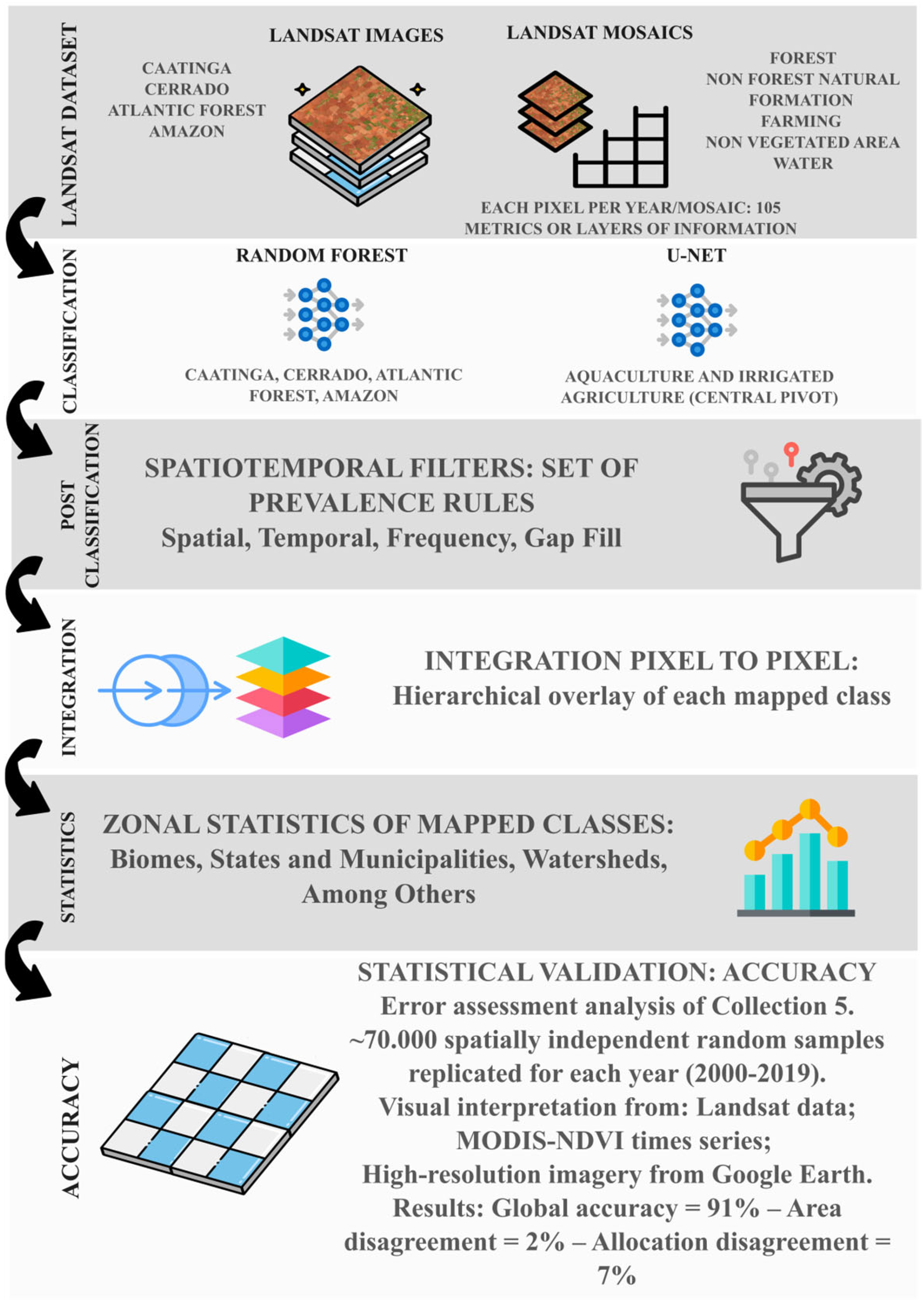
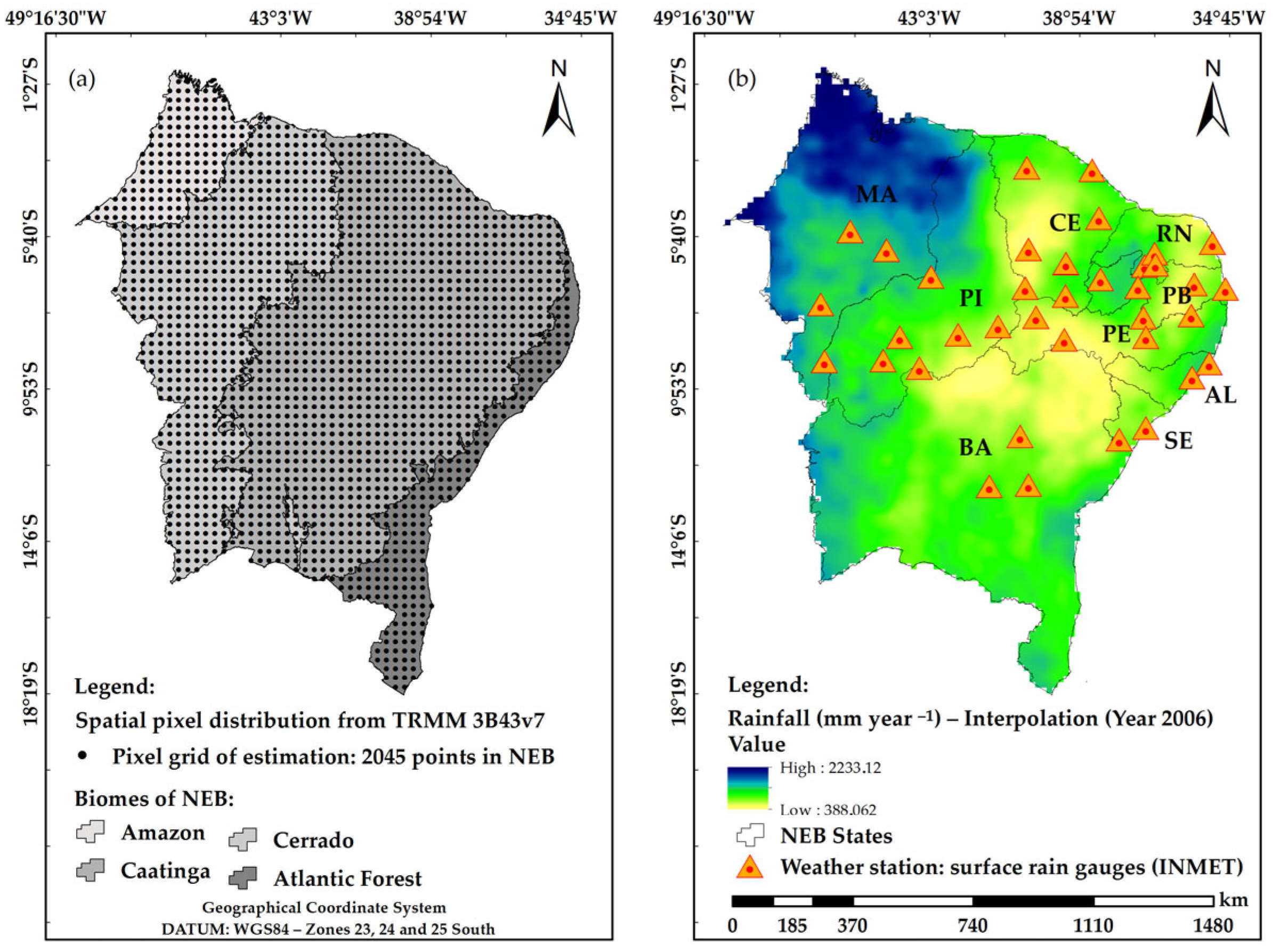
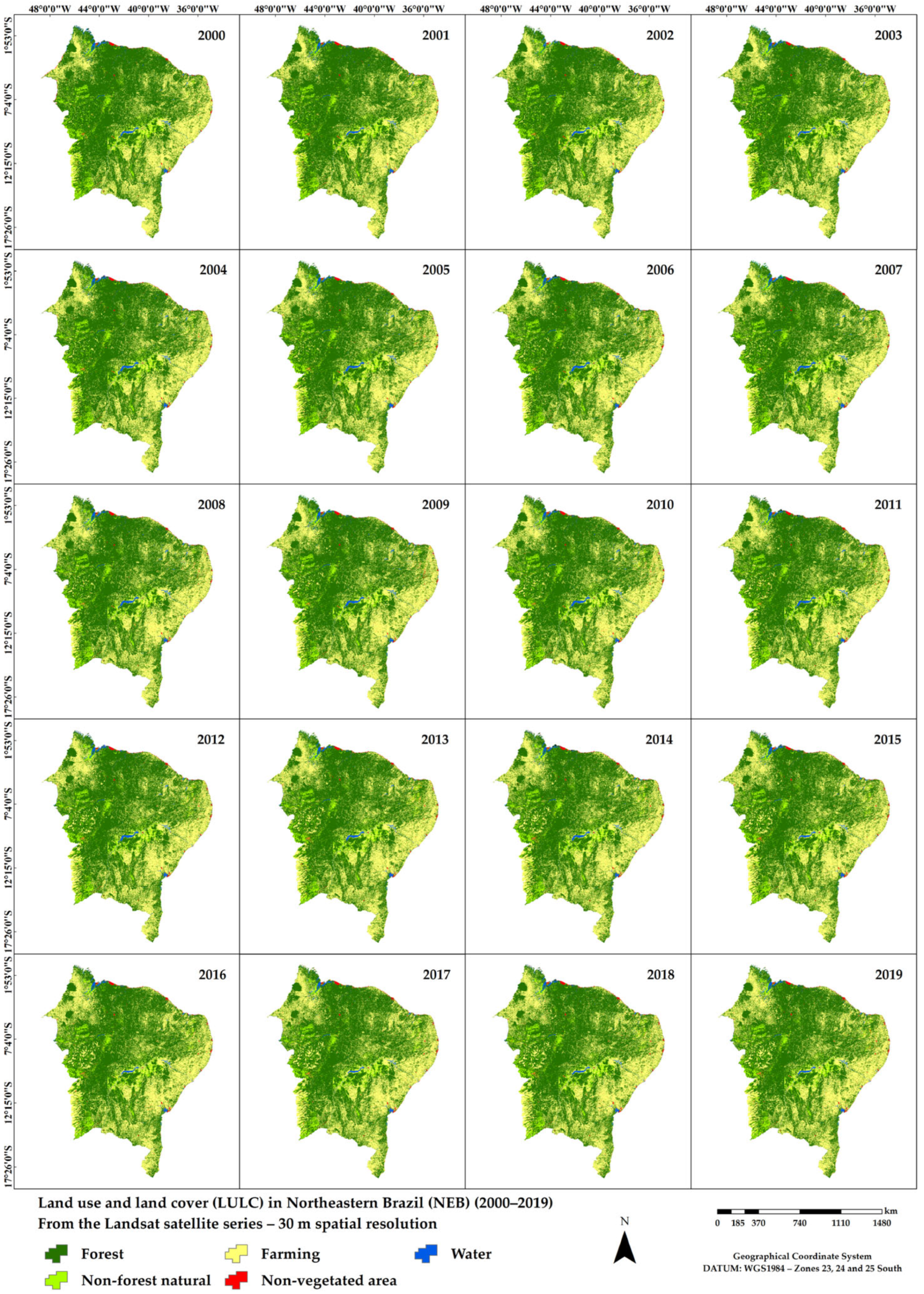
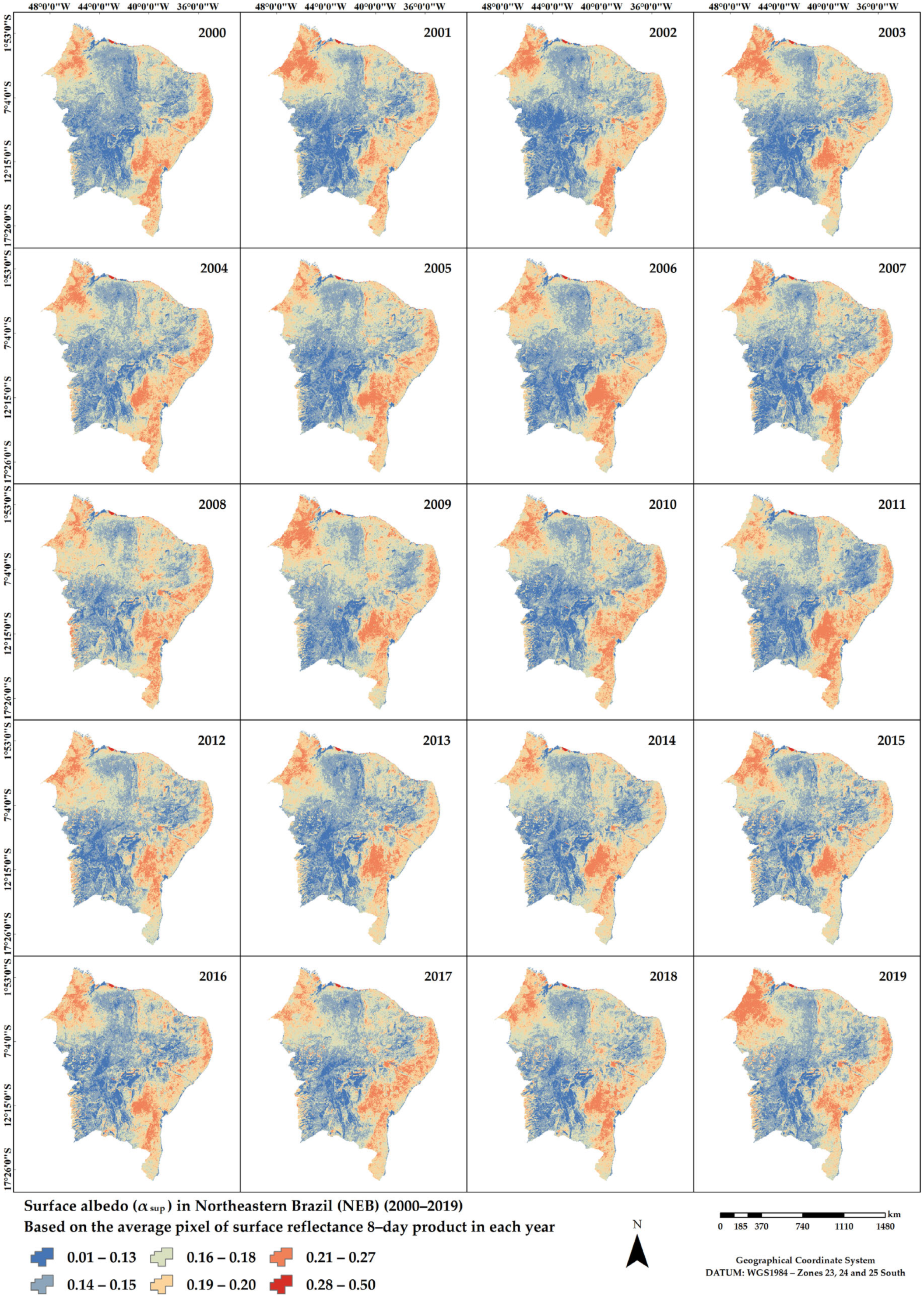
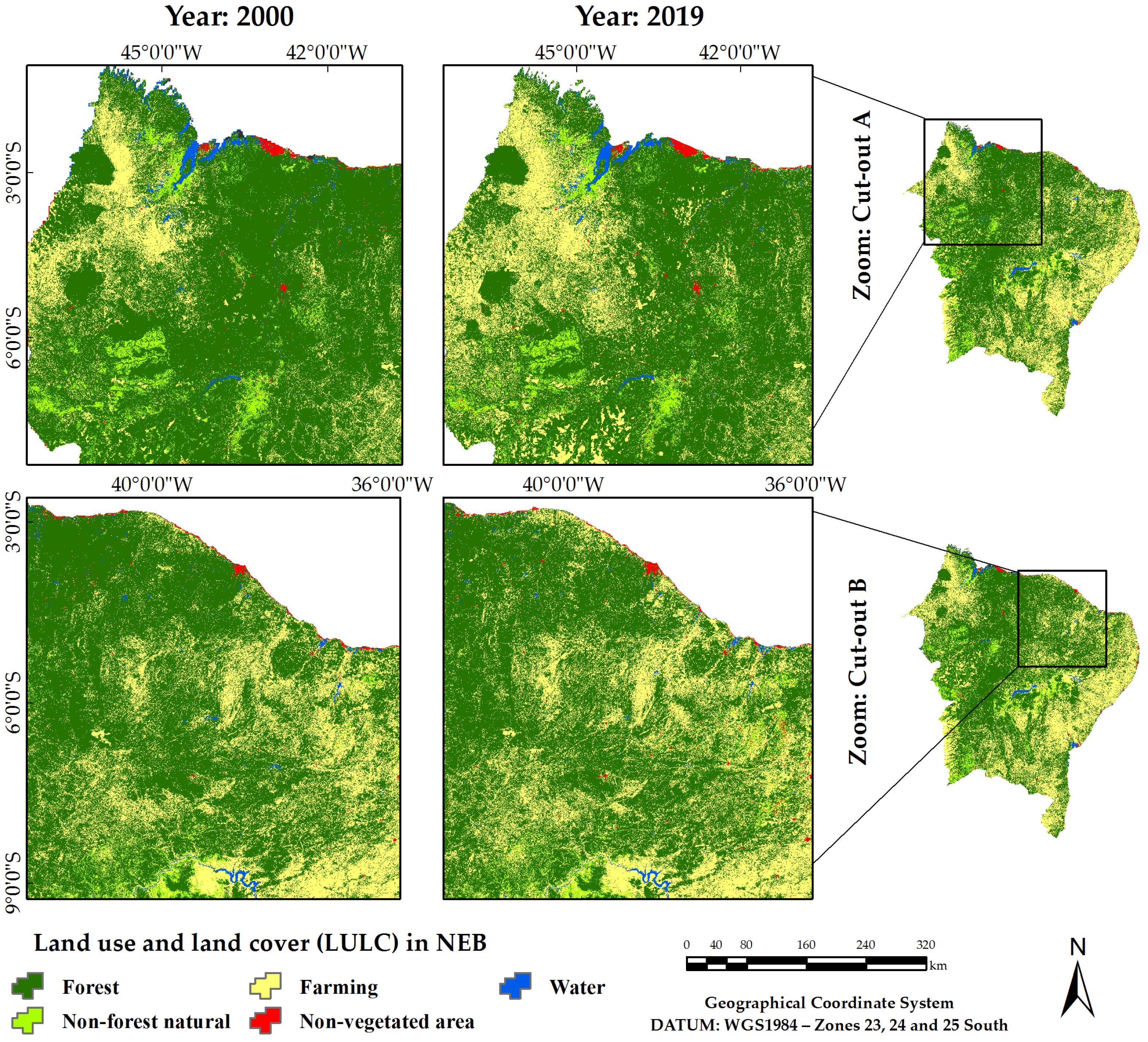

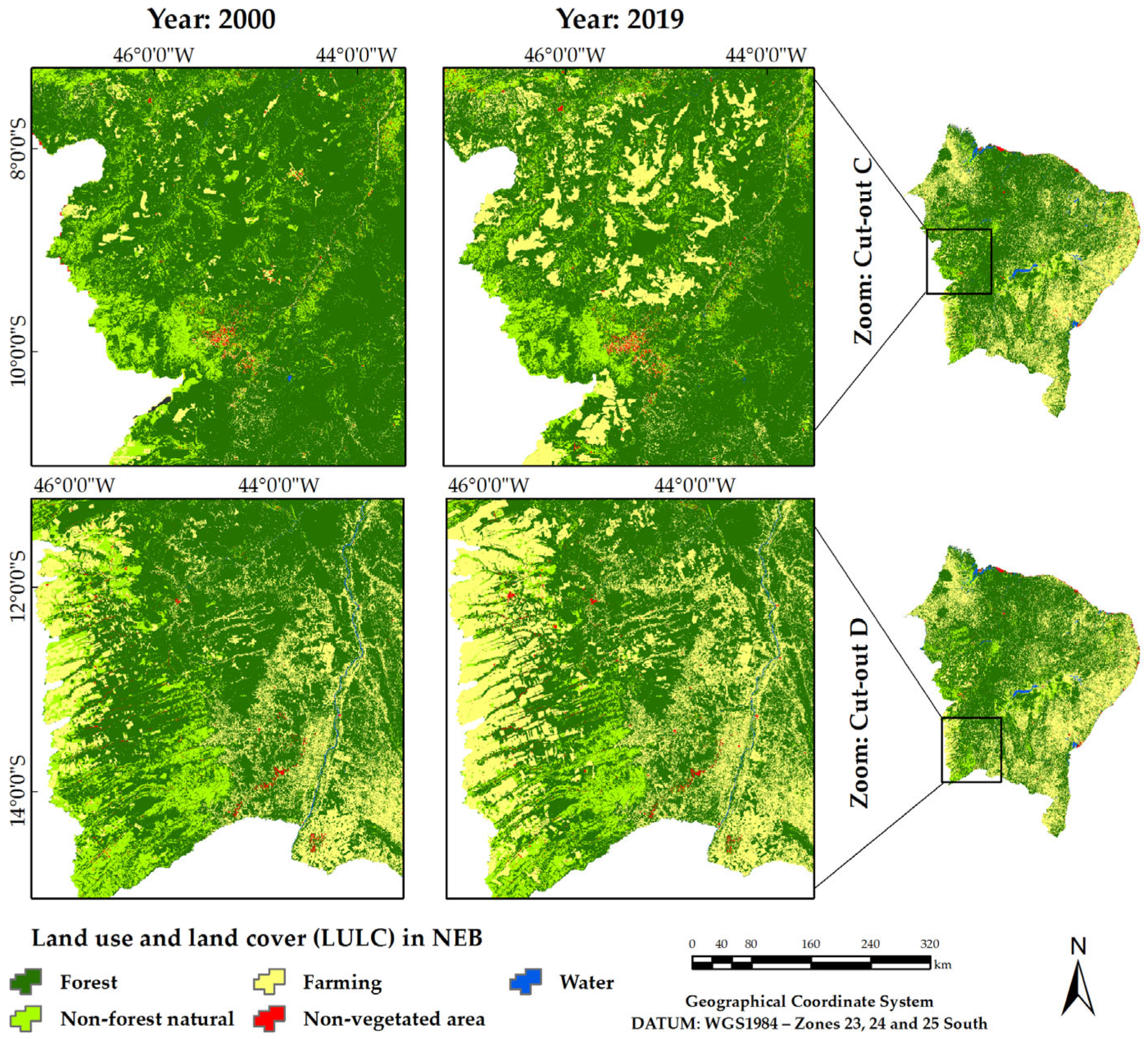
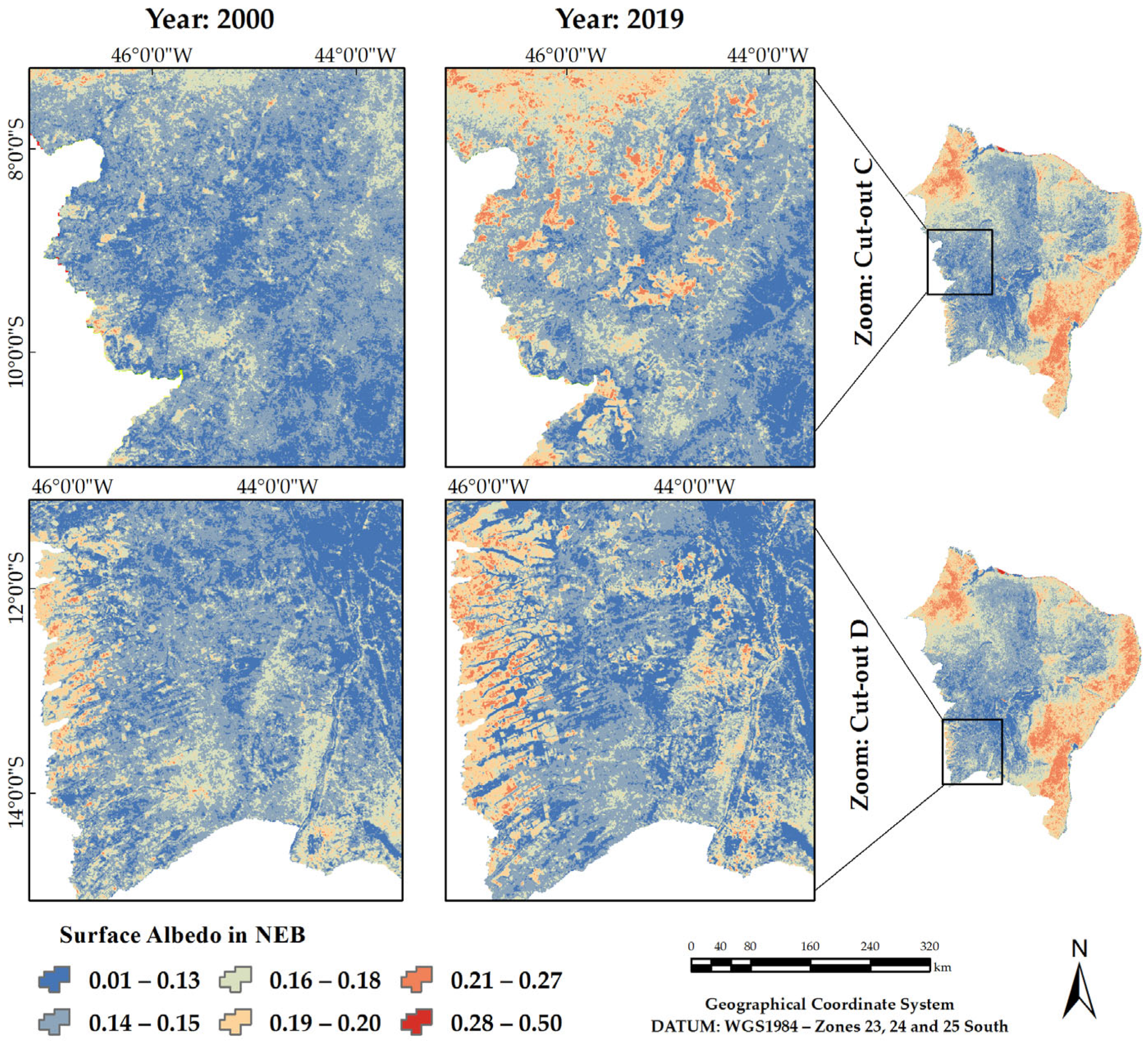
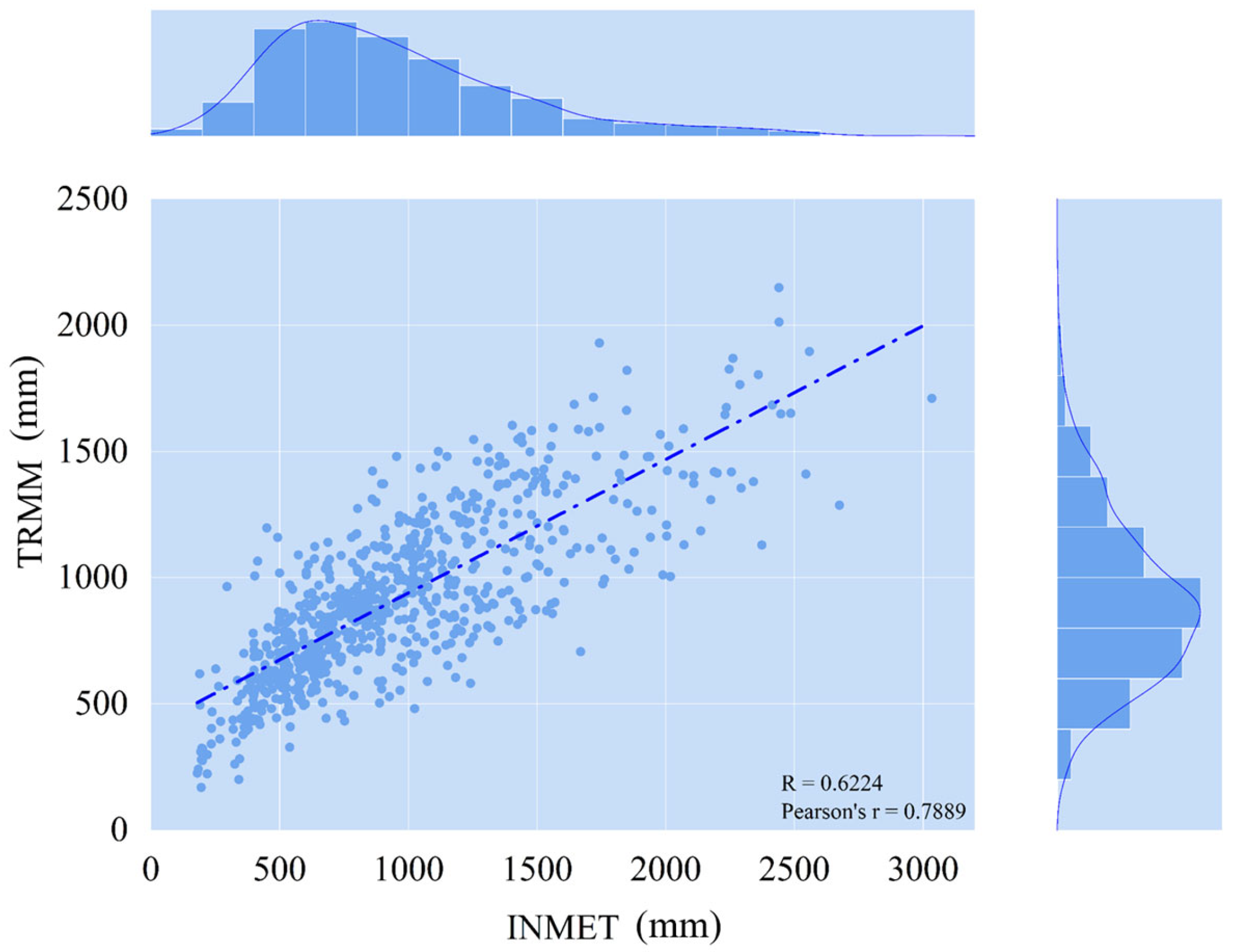
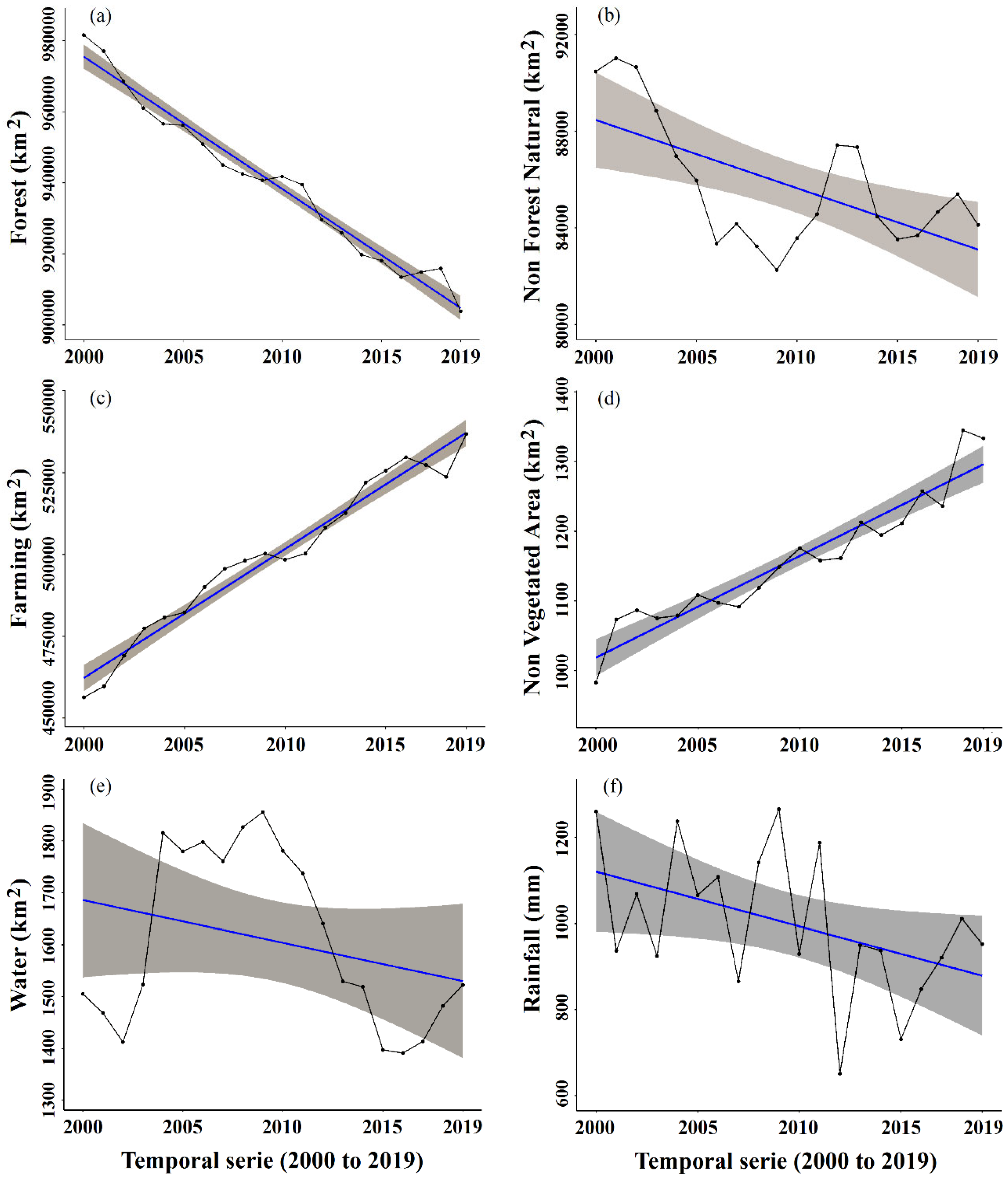
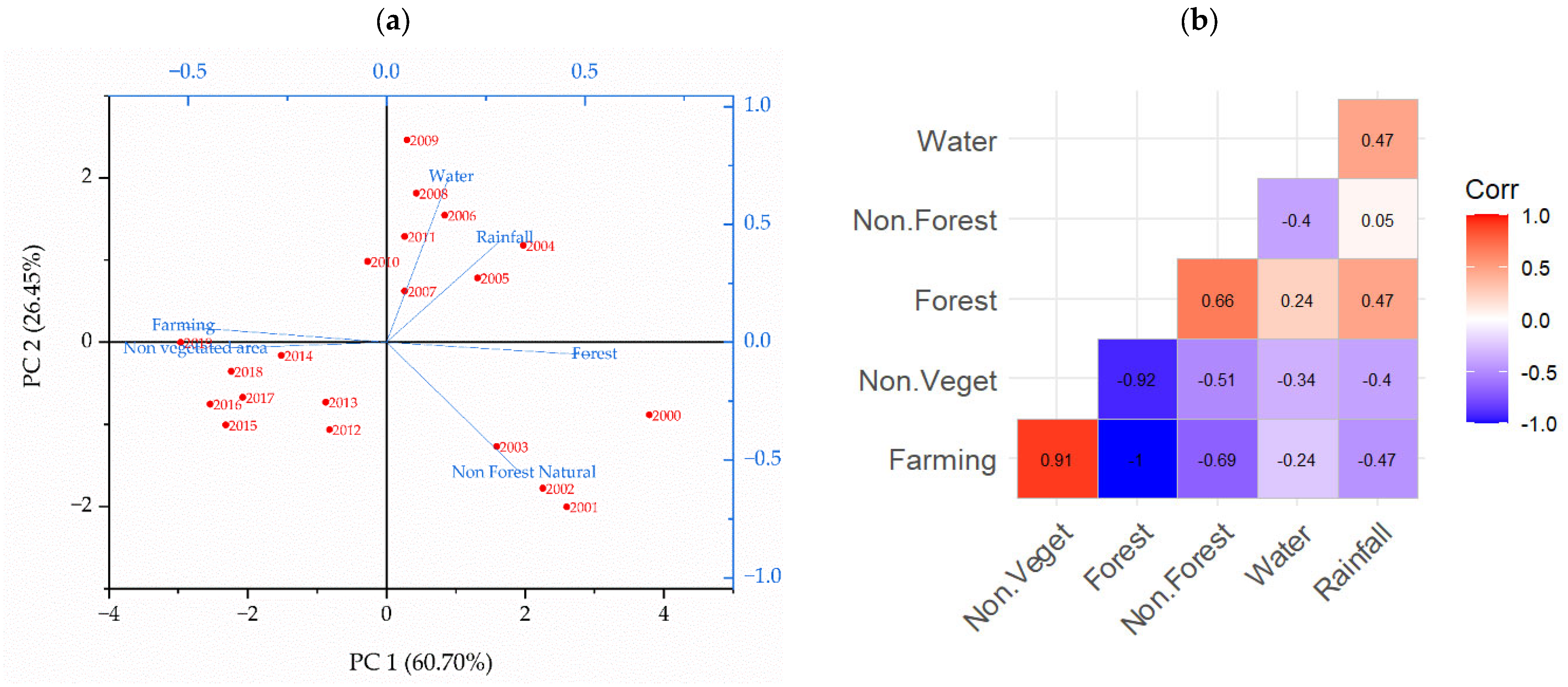
| Satellite | Multispectral Band | Band Description | Wavelength (μm) | Statistical Reducers per Band |
|---|---|---|---|---|
| Landsat-5 TM and Landsat-7 ETM+ | B1 | Blue | 0.45–0.52 | Minimum; Annual median; Dry season median; Rainy season median; Standard deviation |
| B2 | Green | 0.52–0.60 | ||
| B3 | Red | 0.63–0.69 | ||
| B4 | Near infrared—NIR | 0.76–0.90 | ||
| B5 | Shortwave infrared 1—SWIR1 | 1.55–1.75 | ||
| B6 | Thermal infrared | 10.40–12.50 | ||
| B7 | Shortwave infrared 2—SWIR2 | 2.08–2.35 | ||
| Landsat-8 OLI/TIRS | B2 | Blue | 0.45–0.51 | |
| B3 | Green | 0.53–0.59 | ||
| B4 | Red | 0.64–0.67 | ||
| B5 | Near infrared—NIR | 0.85–0.88 | ||
| B6 | Shortwave infrared 2—SWIR1 | 1.57–1.65 | ||
| B7 | Shortwave infrared 2—SWIR2 | 2.11–2.29 | ||
| B10 | Thermal infrared | 10.60–11.19 |
| Spectral Index | Equation | Source/Authors | Statistical Reducers per Band |
|---|---|---|---|
| Cellulose Absorption Index—CAI | CAI = SWIR2/SWIR1 | Nagler et al. [56] | Amplitude; Maximum; Minimum; Annual median; Dry season median; Rainy season median; Standard deviation |
| Enhanced Vegetation Index 2—EVI 2 | EVI 2 = 2.5 × (NIR − Red)/(NIR + 2.4 × Red + 1) | Parente et al. [57] | |
| Green Chlorophyll Vegetation Index—GCVI | GCVI = (NIR/Green − 1) | Burke et al. [58] | |
| Hall Cover | Hall Cover = (– Red × 0.017 − NIR × 0.007 − SWIR2 × 0.079 + 5.22) | Hall et al. [59] | |
| Normalized Difference Vegetation Index—NDVI | NDVI = (NIR − Red)/(NIR + Red) | Rouse et al. [60] | |
| Normalized Difference Water Index—NDWI | NDWI = (NIR − SWIR1)/(NIR + SWIR1) | Gao et al. [61] | |
| Normalized Difference Fraction Index—NDFI | NDFI = (GV − (NPV + SOIL))/(GV + NPV + SOIL) | USGS | |
| Photochemical Reflectance Index—PRI | PRI = (Blue − Green)/(Blue + Green) | Gamon et al. [62] | |
| Soil-Adjusted Vegetation Index—SAVI | SAVI = 1.5 × (NIR − Red)/(NIR + Red + 0.5) | Huete et al. [63] | |
| Surface Index | Equation | Source/Authors | Statistical reducers per band |
| Hall’s Forest Cover | HFC = −0.017 × RED − 0.007 × NIR − 0.079 × SWIR2 + 5.22 | - | Annual median; Dry season median; Rainy season median |
| Hall’s Forest Height | HFH = −0.039 × RED − 0.011 × NIR − 0.026 × SWIR1 + 4.13 | - | |
| Index/Fraction | Equation | Source/Authors | Statistical reducers per band |
| Green Vegetation Fraction—GV | GV = Fractional abundance of green vegetation within the pixel | Souza et al. [64] | Amplitude; Maximum; Minimum; Annual median; Dry season median; Rainy season median; Standard deviation |
| Green Vegetation Shade Fraction—GVS | GVS = GV/(GV + NPV + Soil + Cloud) | Housman et al. [65] | |
| Normalized Difference Fraction Index—NDFI | NDFI = (GVS − (NPV + Soil))/(GVS + (NPV + Soil)) | Souza et al. [64] | |
| Non-photosynthetic Vegetation Fraction—NPV | NPV = Fractional abundance of non-photosynthetic vegetation within the pixel | Souza et al. [64] | |
| Savanna Ecosystem Fraction Index—SEFI | SEFI = (GV + NPV_S − Soil)/(GV + NPV_S + Soil) | Alencar et al. [66] | |
| Shade Fraction—Shade | Shade = 100 − (GV + NPV + Soil + Cloud) | Housman et al. [65] | |
| Soil Fraction—Soil) | Soil = Fractional abundance of soil within the pixel | Souza et al. [64] | |
| Wetland Ecosystem Fraction Index—WEFI | WEFI = ((GV + NPV) − (Soil + Shade))/((GV + NPV)) + (Soil + Shade)) | Rosa [67] | |
| Spectral Mixture Analysis | Equation | Source/Authors | Statistical reducers per band |
| Green Vegetation | GV = SMA(GV) × 100 | Fraction from SMA | Annual median; Standard deviation |
| Soil | SOIL = SMA(Soil) × 100 | ||
| Forest/Non-Forest Index | FNS = 100 × (GVshade − SOIL)/(GVshade + SOIL) + 100 | Adapted from NDFI | |
| GVshade = GV + |GV + NPV + SOIL − 100| | |||
| Scaled Water-Enhanced Forest Index | WEFI = ((GV + NPV) − (SOIL + SHADE))/((GV + NPV) + (SOIL + SHADE)) × 100 + 100 | Fraction from SMA | |
| Land Slope | Global digital surface model: 30 m | Tadono et al. [68] | |
| Band/MODIS | Wavelength | Spatial Resolution (Meters) | Temporal Resolution (Days) | Radiometric Resolution (Bits) | Processing Level | Multiplier Factor (for Each Band) |
|---|---|---|---|---|---|---|
| rBLUE | 0.459–0.479 µm | 500 | 8 | 16 | L3 | 0.0001 |
| rGREEN | 0.545–0.565 µm | |||||
| rRED | 0.620–0.670 µm | |||||
| rNIR1 | 0.841–0.876 µm | |||||
| rNIR2 | 1.230–1.250 µm | |||||
| rSWIR1 | 1.628–1.652 µm | |||||
| rSWIR2 | 2.105–2.155 µm |
| Biome/Collection | Global Accuracy (%) | Area Disagreement (%) | Allocation Disagreement (%) |
|---|---|---|---|
| Caatinga | 81.8 | 3.5 | 14.7 |
| Cerrado | 83.8 | 4.9 | 11.3 |
| Atlantic Forest | 90.7 | 2.0 | 7.3 |
| Amazon | 97.6 | 0.8 | 1.6 |
| Collection 5 | 91.0 | 2.0 | 7.0 |
| Inclusion Errors | |||||
|---|---|---|---|---|---|
| Mapped Class | Forest | Non-Forest Natural | Farming | Non-Vegetated Area | Water |
| Forest | 0.93 | −0.02 | −0.04 | −0.0002 | −0.001 |
| Non-forest natural | −0.17 | 0.70 | −0.12 | −0.001 | −0.005 |
| Farming | −0.05 | −0.03 | 0.91 | −0.003 | −0.0009 |
| Non-vegetated area | −0.01 | −0.0052 | −0.03 | 0.95 | 0.00 |
| Water | −0.01 | −0.04 | −0.006 | −0.00002 | 0.94 |
| Errors of omission | |||||
| Forest | 0.96 | −0.02 | −0.02 | −0.00006 | −0.0002 |
| Non-forest natural | −0.19 | 0.68 | −0.12 | −0.0002 | −0.009 |
| Farming | −0.11 | −0.03 | 0.85 | −0.0005 | −0.00035 |
| Non-vegetated area | −0.02 | −0.02 | −0.20 | 0.76 | −0.00007 |
| Water | −0.05 | −0.02 | −0.01 | 0.00 | 0.91 |
| Year | Forest | Non-Forest Natural | Farming | Non-Vegetated Area | Water | Non Observed | Rainfall (TRMM) |
|---|---|---|---|---|---|---|---|
| Total Area of Classes: 1,553,402 km2 | mm Year−1 | ||||||
| 2000 | 981,577.33 | 90,468.03 | 456,363.72 | 9826.71 | 15,050.78 | 115.41 | 1261 |
| 2001 | 977,099.95 | 91,018.30 | 459,750.94 | 10,732.90 | 14,685.71 | 114.19 | 937 |
| 2002 | 968,541.36 | 90,650.87 | 469,107.64 | 10,865.84 | 14,121.95 | 114.33 | 1069 |
| 2003 | 961,045.17 | 88,843.80 | 477,413.53 | 10,749.36 | 15,234.77 | 115.35 | 925 |
| 2004 | 956,590.84 | 86,963.71 | 480,788.55 | 10,788.43 | 18,154.12 | 116.35 | 1238 |
| 2005 | 956,164.28 | 85,964.77 | 482,273.70 | 11,083.97 | 17,798.70 | 116.51 | 1066 |
| 2006 | 950,886.47 | 83,349.65 | 490,099.75 | 10,972.04 | 17,977.24 | 116.84 | 1108 |
| 2007 | 945,015.92 | 84,166.35 | 495,581.57 | 10,915.87 | 17,605.67 | 116.61 | 866 |
| 2008 | 942,529.53 | 83,239.95 | 498,061.55 | 11,188.72 | 18,265.55 | 116.69 | 1142 |
| 2009 | 940,718.53 | 82,260.09 | 500,258.79 | 11,490.75 | 18,556.61 | 117.22 | 1266 |
| 2010 | 941,757.29 | 83,572.40 | 498,390.82 | 11,757.79 | 17,807.39 | 116.30 | 930 |
| 2011 | 939,495.92 | 84,562.89 | 500,277.41 | 11,580.49 | 17,370.16 | 115.11 | 1188 |
| 2012 | 929,616.57 | 87,419.77 | 508,230.95 | 11,613.88 | 16,407.51 | 113.32 | 651 |
| 2013 | 925,884.22 | 87,341.30 | 512,643.20 | 12,127.84 | 15,293.59 | 111.84 | 950 |
| 2014 | 919,758.51 | 84,463.21 | 521,930.22 | 11,946.48 | 15,190.72 | 112.85 | 938 |
| 2015 | 918,074.91 | 83,524.76 | 525,599.75 | 12,114.83 | 13,973.08 | 114.67 | 731 |
| 2016 | 913,452.63 | 83,687.29 | 529,657.71 | 12,576.51 | 13,911.23 | 116.62 | 848 |
| 2017 | 914,847.99 | 84,653.53 | 527,286.50 | 12,359.62 | 14,135.78 | 118.55 | 921 |
| 2018 | 915,881.56 | 85,401.19 | 523,671.08 | 13,449.02 | 14,820.50 | 178.63 | 1011 |
| 2019 | 903,850.95 | 84,122.09 | 536,750.41 | 13,334.88 | 15,224.77 | 118.883 | 953 |
| Descriptive and dispersion statistics | |||||||
| Minimum | 903,850.95 | 82,260.09 | 456,363.72 | 9826.72 | 13,911.23 | 111.84 | 651.00 |
| Mean | 940,139.50 | 85,783.70 | 499,706.89 | 11,573.80 | 16,079.30 | 118.81 | 999.95 |
| Maximum | 981,577.33 | 91,018.31 | 536,750.41 | 13,449.03 | 18,556.62 | 178.63 | 1266.00 |
| 1 SD | 22,332.43 | 2696.57 | 23,723.34 | 910.82 | 1670.97 | 116.33 | 951.50 |
| 2 CV (%) | 2.38 | 3.14 | 4.75 | 7.87 | 10.39 | 14.19 | 168.03 |
| LULC Data and Rainfall Data | Mann–Kendall Trend Test | |||
|---|---|---|---|---|
| ZMK-Value | Tau | Sen’s Slope | p-Value | |
| Forest | −5.872 | −0.958 | −3705.853 | 4.29 × 10−9 ** |
| Non-forest natural | −1.914 | −0.316 | −277.263 | 0.055 ns |
| Farming | 5.807 | 0.947 | 3978.898 | 6.34 × 10−9 ** |
| Non-vegetated area | 5.418 | 0.884 | 137.084 | 6.02 × 10−8 ** |
| Water | −1.330 | −0.221 | −93.586 | 0.183 ns |
| Rainfall/TRMM | −1.460 | −0.242 | −11.878 | 0.144 ns |
Disclaimer/Publisher’s Note: The statements, opinions and data contained in all publications are solely those of the individual author(s) and contributor(s) and not of MDPI and/or the editor(s). MDPI and/or the editor(s) disclaim responsibility for any injury to people or property resulting from any ideas, methods, instructions or products referred to in the content. |
© 2025 by the authors. Licensee MDPI, Basel, Switzerland. This article is an open access article distributed under the terms and conditions of the Creative Commons Attribution (CC BY) license (https://creativecommons.org/licenses/by/4.0/).
Share and Cite
Silva, J.L.B.d.; Silva, M.V.d.; Lopes, P.M.O.; Santos, R.C.; Carvalho, A.A.d.; Moura, G.B.d.A.; Silva, T.G.F.d.; Cézar Bezerra, A.; Jardim, A.M.d.R.F.; Ferreira, M.B.; et al. Land Use and Land Cover Change Patterns from Orbital Remote Sensing Products: Spatial Dynamics and Trend Analysis in Northeastern Brazil. Land 2025, 14, 1954. https://doi.org/10.3390/land14101954
Silva JLBd, Silva MVd, Lopes PMO, Santos RC, Carvalho AAd, Moura GBdA, Silva TGFd, Cézar Bezerra A, Jardim AMdRF, Ferreira MB, et al. Land Use and Land Cover Change Patterns from Orbital Remote Sensing Products: Spatial Dynamics and Trend Analysis in Northeastern Brazil. Land. 2025; 14(10):1954. https://doi.org/10.3390/land14101954
Chicago/Turabian StyleSilva, Jhon Lennon Bezerra da, Marcos Vinícius da Silva, Pabrício Marcos Oliveira Lopes, Rodrigo Couto Santos, Ailton Alves de Carvalho, Geber Barbosa de Albuquerque Moura, Thieres George Freire da Silva, Alan Cézar Bezerra, Alexandre Maniçoba da Rosa Ferraz Jardim, Maria Beatriz Ferreira, and et al. 2025. "Land Use and Land Cover Change Patterns from Orbital Remote Sensing Products: Spatial Dynamics and Trend Analysis in Northeastern Brazil" Land 14, no. 10: 1954. https://doi.org/10.3390/land14101954
APA StyleSilva, J. L. B. d., Silva, M. V. d., Lopes, P. M. O., Santos, R. C., Carvalho, A. A. d., Moura, G. B. d. A., Silva, T. G. F. d., Cézar Bezerra, A., Jardim, A. M. d. R. F., Ferreira, M. B., Silva, P. C., Silva, J. A. O. S., Mesquita, M., Batista, P. H. D., Jordan, R. A., & Oliveira, H. F. E. d. (2025). Land Use and Land Cover Change Patterns from Orbital Remote Sensing Products: Spatial Dynamics and Trend Analysis in Northeastern Brazil. Land, 14(10), 1954. https://doi.org/10.3390/land14101954













